Viewer Options Actually Benefit the Entire Entertainment Ecosystem
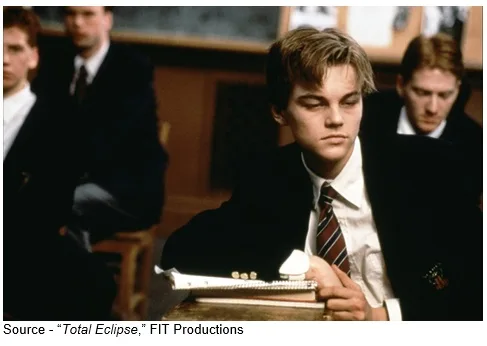
Attention streaming video folks.
Yes, we really, really like Netflix, Amazon Prime, Hulu, Apple TV+, Disney + stuff.
We like this and that on BritBox and HBO, or whatever you’re calling it today.
So why didn’t we throw Peacock, Pluto, Tubi into the pile? They’re free.
If we lived in China, we’d like Youku, iQuyi, LeTV and Tencent Video stuff.
If we were in India, we’d like Hotstar, Hungama, Spuul and Jio Cinema stuff.
If we were in Europe, we’d like Cinesquare, Uncut and Joyn+ stuff.
If we were in Africa, it would be APAC, EMEA; yeah, different stuff.
Get the picture?
It’s not about you.
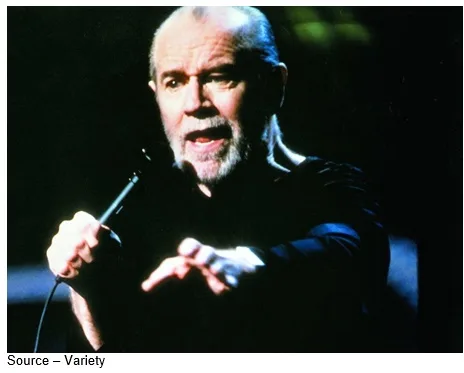 As George Carlin so aptly put it (https://bit.ly/2EXm0tq), “it’s about your S***, my stuff!”
As George Carlin so aptly put it (https://bit.ly/2EXm0tq), “it’s about your S***, my stuff!”
Back in 2019 BC (Before Covid), everyone swore:
- People were going to cut their expensive, so-so cable service
- Netflix was going to kill itself with debt buying, creating outstanding content
- Studios – Disney, Paramount, Sony, Universal – were going to overrun Netflix with their movie library
- Networks – ABC, NBC, CBS – were going to stomp on Netflix with all of their TV series, reality shows, etc.
So, what happened?
Yeah, we kept our cable because our Internet connection is attached.
We added Netflix, Amazon Prime (free shipping), Disney + (Hulu comes in our bundle), Apple TV + and we signed up for the free ones Peacock, Tubi, Pluto.
And we get our exercise in the evening with 15-20 minutes of finger-clicking, going from service to service to find the one thing we want to watch.
Usually, we end up … settling!
It’s true, we didn’t for Mulan. We dropped $30 on top of our annual fee.

We got to watch Black Panther free, thanks to ABC (Disney) as well as 42 and Da 5 Bloods on Netflix. Yes, we called it a Chadwick Boseman day to appreciate what we’d lost.
A friend dropped $20 to watch Love and Monsters.
Our theater-loving lady friend (Sarah B) took a bargain flight to Austin, TX to see Tenet at the AMC theater. Hey, she likes movies in movie houses, and nothing was open in CA.
Once she’s seen it … she’s seen it!
We’re the same with our DTC services … once we’ve seen it, we’re done with it.
Or, to put it less subtly … Netflix don’t suggest it again … and again.
Actually, we read a piece recently by someone who said if you watched all of the stuff on Netflix right now, it would take you four years, round-the-clock.
Disney+, Amazon, Peacock would be worse.
Sorry to tell you Reid/Ted, Bob, Jeff, Tim, Brian and your “people” but we don’t like everything you put out and we simply don’t have the time to be brain dead that long to watch … stuff!
So, like the cable we really should cut because of the “wasted” content, we’ll probably need to take a real close look at our services and see which of them have the fewest “gawd we’ve gotta see that” shows and cancel one or two.
Naw … probably won’t.
But still, the idea is tempting; and as weird as it sounds, one or two that go will probably be the ad-supported broadcast streaming channels.
Don’t get us wrong, the ads aren’t that frequent and each time they’re presented, they’re more accurate and more personalized.
The “more accurate” part is the marketers’ problem. They simply haven’t figured out yet that with IP addresses, you can be creative in short spots and more personalized.
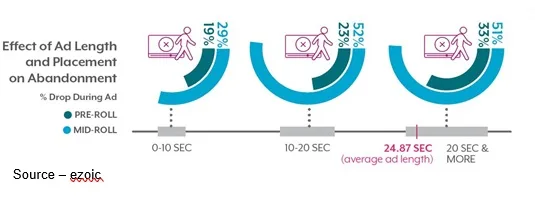
O.K., the other part of the problem is that streaming folks are working out how to sell the spots in a more precise way, which is different from the old days where they sold a block of slots.
You know, you saw the same ad again … and again … and …
Really wish they’d get some indie filmmakers involved at the outset to help them put some creative into their creative.
We were discussing the richness of the content, its spread across multiple services and the cost with Allan McLennan, chief executive of PADEM Media Group, when he said, “The problem/challenge for people in the middle of the lockdown and pandemic is rapidly becoming subscription fatigue. ‘Everyone’ who has developed a new streaming service believe their’s will be the one that everyone in the country/world will just beg to have.
“As we move past this crisis and move into an adjusted engagement behavior, viewers will start to step out of their homes, discover more to consider doing, will learn the favorites of others and will start to be more selective,” he continued. “Subscriptions will then have to evolve and be more flexible. Ultimately, we’ll arrive at the point where we will have two to three, perhaps four major global platforms and a rich underlying offering of niche players.
“One price fits all simply isn’t going to be sustainable,” he added. “If the OTT services don’t become more attuned to what their viewers want, need – and can afford, they’ll simply abandon the platforms that don’t listen. Streamers need to remember that their viewers now have more options and they’re increasingly willing to jump ship!
And while viewers liked the idea of watching rich content in the safety of their own home, communities worldwide reminded the industry that there is still a high level of interest in attending a local cinema.”
Theater management did an excellent job of reassuring ticket holders that they were focused on the safety of each individual as they slowly reopened theaters with the strongest titles that were available – Tenet, The Eight Hundred and yes, Mulan, in China.
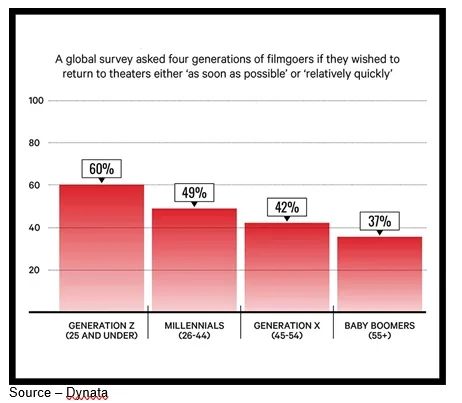
Around the globe, Gen Zers and millennials showed they were ready to resume – and in many cases begin – their communal entertainment experience.
The more than 7,000 cinemas across China enjoyed “record” crowds, despite the governmental restrictions of 50 percent occupancy.
Artisan Gateway, the country’s box office tracker, noted that it was rare for Chinese cinemas to exceed 50 percent capacity prior to the pandemic so exhibitors didn’t even notice an impact in ticket sales.
The same was true for AMC, Cineworld, Cinemark, Cinemex, Cineplex and even funky little out-of-the-way art cinemas across the Americas and Europe.
Chinese theater owners held their breath with the opening and extended run of the patriotic film, The Eight Hundred, followed by Warner’s Tenet and Disney’s Mulan.
The Eight Hundred racked up nearly $300M in ticket sales in China and the country’s theater goers helped Tenet bring in $300M in more than 40 countries.
Even Mulan – another strong Chinese patriotic story that did well as a Disney PVOD offering – filled the country’s cinema seats.
While theater owners are still struggling to recover from the six-months plus closure and operating in new and different ways, the pandemic-induced hibernation may have rekindled people’s interest/need to see a movie in a cinema with others.
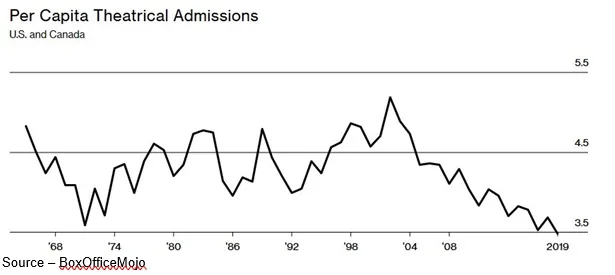
Admit it.
People were ignoring the need to go out to the movie even before the pandemic and the governmental health lockdown provided studios, content owners and services to meet the consumer’s entertainment needs in a more relaxed environment … their own home.
Online streaming services helped the total ecosystem make it through the pandemic but the initial rush to the box office also indicates that the film industry is resilient and that perhaps the new, more flexible theatrical windowing isn’t so bad after all.
Because of the forced closures, theaters around the globe find themselves with an embarrassment of rich film content that was developed, produced and put in cold storage in 2019 and the first half of 2020.
As video projects cautiously start up again, there are strong indications that 2021/22 could be excellent for studios and streamers.
Both parties will have to be flexible and realistic about the value of the content.
Lots of people are showing that it’s important to get out, go to the movie and laugh, cry with strangers.
But there are an equal/greater number who dismissed going to the movie pre-pandemic and the eight months staying home and watching new content on their screen(s) has become a better alternative.
Disney, Universal, Paramount and yes even Warner have to come to grips with the facts that there are subtle differences between viewers in each country and content value should be based on the consumers’ perception, not the studio or the budget spend.
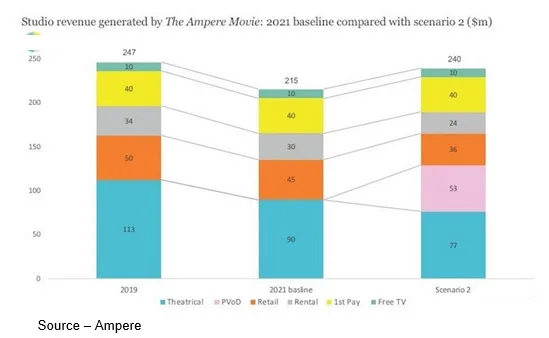
“Before the pandemic, studios were reluctant to challenge the cinema industry’s theatrical release first window,” McLennan observed–especially if it was a mid-tier or tentpole film.
“But with theaters closed and a dim view of what tomorrow might hold, studios held all of the cards so they could experiment with alternatives,” he said. “Universal went DTC with Trolls, generating upwards of $150M in online sales and proved the viability of selectively going to the consumer first. That encouraged AMC to readjust the unbreakable theatrical window going forward.
“Disney, on the other hand, used their content to brilliantly build its subscriber base with a commitment to release its productions again in theaters when they reopened,” he added. “It worked for the two studios and we believe in the long run, the new flexibility will be best for everyone.”
As Ampere recently pointed out, the shortened window could prove to be beneficial to both parties.
Cinemas will have the blockbusters first, maximizing their revenues because of the studios’ marketing spend, while having a reliable selection of mid-tier films to keep attendance steady.
At the same time, studios can keep up their theatrical presence, which is where they enjoy the most revenue, while still having a strong VOD offering to retain and expand their subscription base.
They might – just might – get that content if people are reluctant to put their seats in cinema seats in sufficient numbers until there is a Covid vaccine.
After all, we have four subscription and two ad-supported services (Disney ++, Netflix, Amazon Prime, Apple TV +, Pluto and Tubi), which is overkill, to say the least.
First, there’s no more room in the budget (financial and time) when it takes so long to jump from one to the other, searching for something we’ve just “gotta watch.”
And we’re not alone.
Folks in Europe complain about the hide and seek game. Of course, when it comes to soccer or rugby, they’ll find it … or else!
People in India, who tend toward free services, don’t bother with more than three providers.
China, the world’s second largest film market, seems to stick to two services and is willing to fill half of their movie houses to round out their entertainment.
For everyone, the desire to have more options to pay for and waste time searching through is not fun–it’s frustrating.
If a new exciting service comes along, it’s far easier to cancel one and replace it rather than watching your entertainment budget grow.
Actually, people don’t want everything any of the services has to offer.
No, they want a couple of shows from Service A, four from Service B, six from Service C.
So, if Service D can figure out how to customize the library to our interests, we’re there.
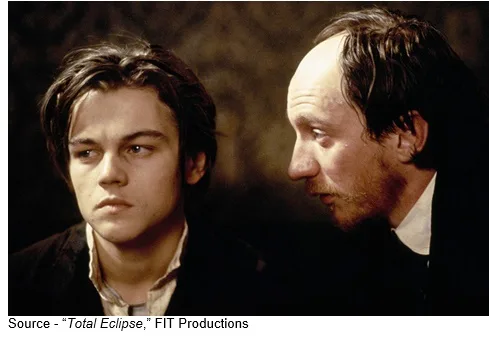 Perhaps a new phase of aggregation will begin … again.
Perhaps a new phase of aggregation will begin … again.
Frankly, searching for entertainment is becoming unbearable.
Maybe that’s what Arthur Rimbaud’s meant in Total Eclipse when he said, “The only unbearable thing is that nothing is unbearable.”
# # #
Andy Marken – [email protected] – is an author of more than 700 articles on management, marketing, communications, industry trends in media & entertainment, consumer electronics, software and applications. An internationally recognized marketing/communications consultant with a broad range of technical and industry expertise especially in storage, storage management and film/video production fields; he has an extended range of relationships with business, industry trade press, online media and industry analysts/consultants.